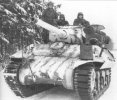I was just mulling over WW2 and its plethora of open-topped armoured vehicles. For example the M10/M36 Tank Destroyers. The open top must be good for situational awareness, but with the downside of being unpleasant for the crew a lot of the time. I can understand the design decision on a lot of the improvised vehicles, e.g. the Marders, for space/weight reasons, and halftracks because the crew need to debus quickly, but that still leaves me with a question over purpose-built equipment like the M10. Even in 1941 the open-top would be vulnerable to shrapnel, air attack and snipers, although these would not be so prevalent as later in the war. On the plus side, you can get out quickly. I was at a military fair a few years ago with Shermans, Cromwells and the like...I had felt my skinny earlier teenage self would have had difficulty getting through those hatches, let alone if it was burning...
You can see it would be "brass monkey weather" for those poor sods in the picture.
As an aside, I just noticed (again) that the M10 doesn't have a co-ax MG, which is another inexplicable omission.
What are your thoughts? Why did US TD Command (or the Ordnance Board) take this decision? It would have added a small amount of cost, weight and complexity to the manufacture, but not that much.
You can see it would be "brass monkey weather" for those poor sods in the picture.
As an aside, I just noticed (again) that the M10 doesn't have a co-ax MG, which is another inexplicable omission.
What are your thoughts? Why did US TD Command (or the Ordnance Board) take this decision? It would have added a small amount of cost, weight and complexity to the manufacture, but not that much.




























